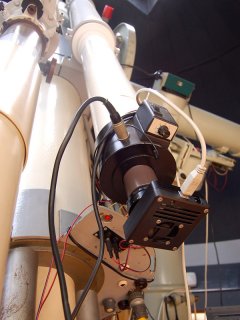|
The digital age at Valasske Mezirici followed the first tests in
1999, when regular observations using CCD TV camera Oscar on the
coronograph telescope started. Data were stored as individual frames
or as short video sequences on the computer or the video sequence was
recorded on standard VCR. The new telescope, capable to observe the
solar chromosphere, was introduced into observations in 2001. Images
from this telescope were also captured by the Oscar camera, but later
this observation program was chosen as a first application of modern
digital CCD camera G1-2000 in Valasske Mezirici Observatory.

The G1-2000 camera on chromospherical telescope in Valasske
Mezirici Observatory The G1-2000 CCD camera on the chromospherical telescope (135/2350
mm, effective focal length 5170 mm, H-alpha filter DayStar 0,7Ä)
offers field of view approx. 4.7' on the longer side of the detector.
Theoretical resolution of this setup, determined by the telescope
itself, is 0,8“ per pixel.
The quality of our observations is highly affected by the
atmospheric seeing. High download rate together with very short
exposure times around 0.001 allows us to select
images acquired in moments with good seeing conditions, which
significantly enhances the whole setup performance.
Test observations are under way at Valasske Mezirici Observatory
from February 2008. Currently the best images of the solar
chromosphere were captured on March 31st, 2008, when some
active regions accompanied with sunspots appeared on the Sun after a
long period of quiet Sun.
Active regions NOAA 10987 (left) and NOAA 10988
(right) The images above contain surroundings of sunspots and structures in
chromosphere in the active regions marked NOAA 10987 and NOAA 10988.
Such observations should allow us to systematically monitor changes in
morphology of active regions, which are connected with their
development and also with solar flares.
We plan to use the another G1-2000 cameras also on the solar
coronograph for monitoring of solar prominences.
Jiri Srba, Valasske Mezirici Observatory (http://www.astrovm.cz/)
|